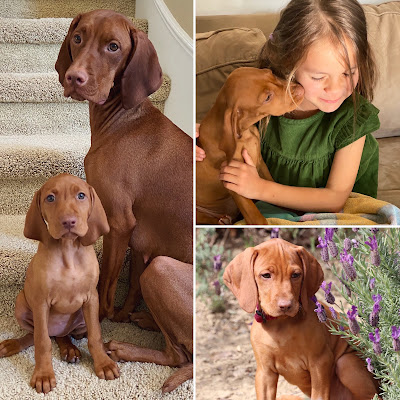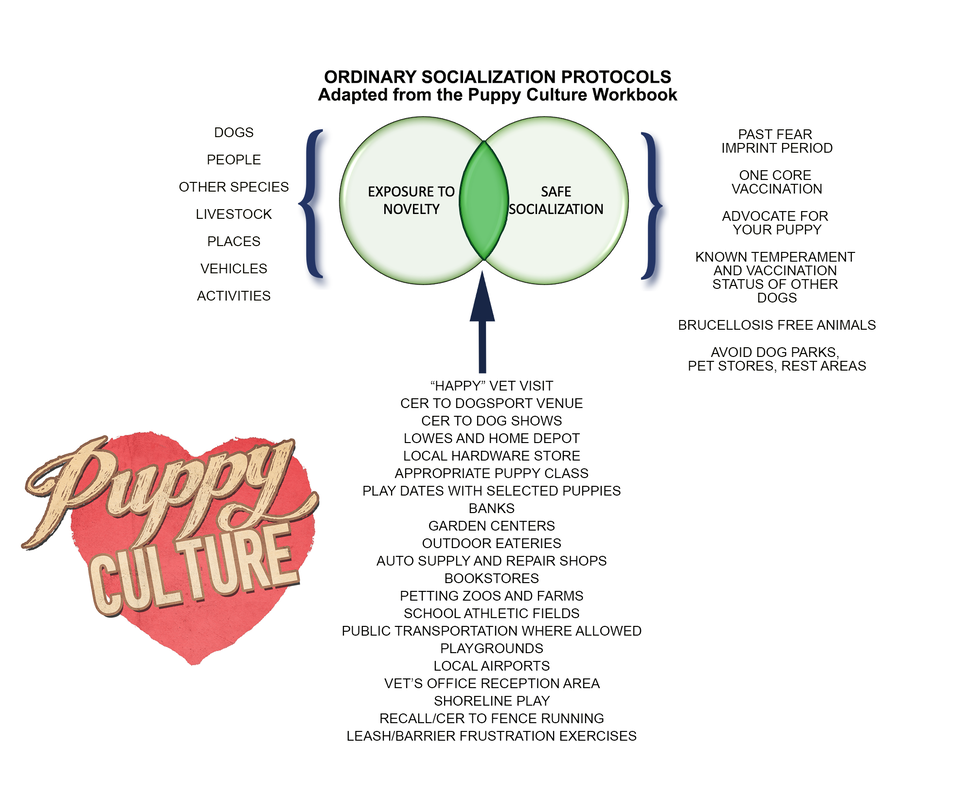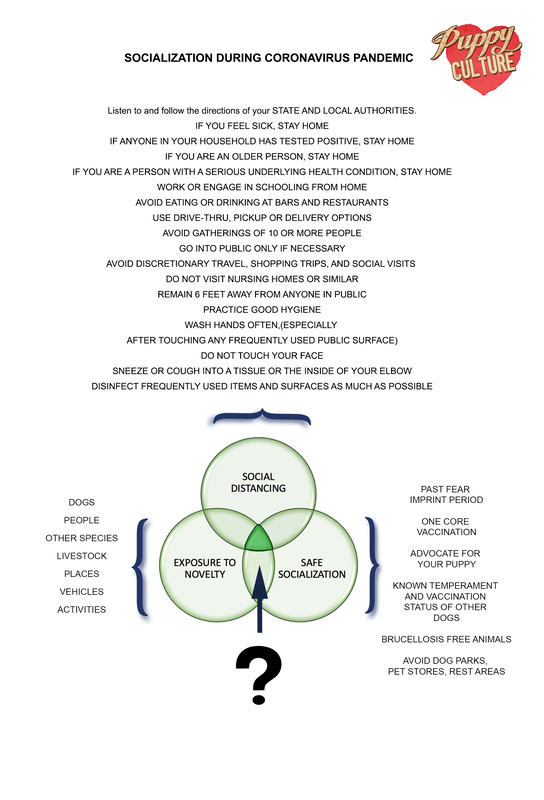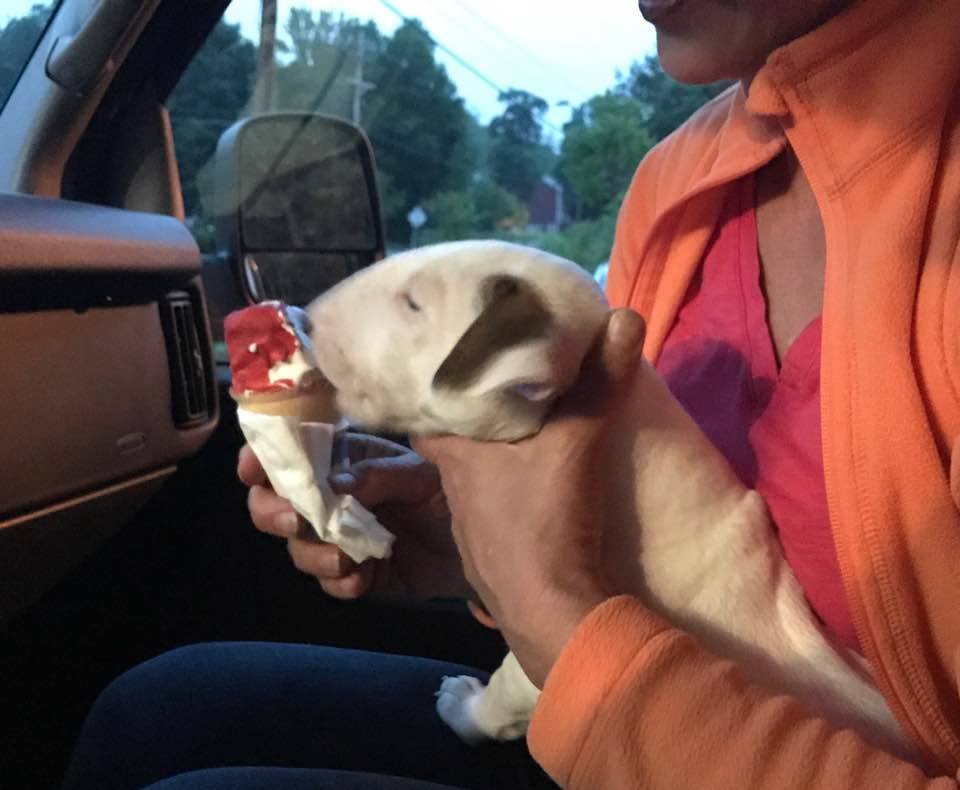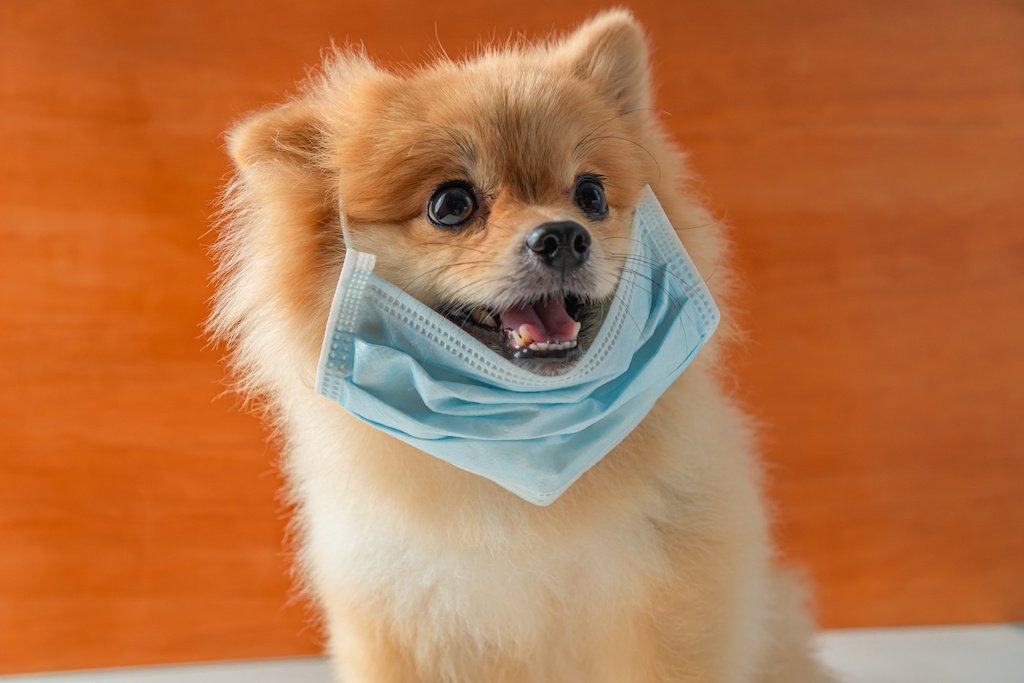Deacon - 21.6 lbs.
Dare - 22.3 lbs.
Ambrose - 30 lbs.
Dublin - 23 lbs.
Gigi - 22.1 lbs.
Phoenix - 27 lbs.
Briggs - 23.5 lbs.
Ripley - 25.6 lbs.
As a general rule you can take this weight and double it for their adult size!
Emery is 40 lbs.
Jett is 46 lbs.
Let's talk about the question that has to be foremost in any breeder's mind right now...socialization during the coronavirus pandemic. I'm in this situation myself with a 12 week old puppy in my house that normally would be in the midst of daily exposures to important things. I've taken a hard look at my past research on socialization and viewed that in light of the US government's call for measures to stop the spread of the virus, and I have, if not a plan, at least a distilled version of the considerations, with some definite "dos," some definite "don'ts" and some definite "it depends." But I will say at the outset this is all very fluid so, in the end, you have to be alert to changing facts and use your own judgement.
Update Friday, March 20, 2020: The governors of California and New York State have ordered 100% of non-essential workers to stay home. Notwithstanding anything in this article, please comply with all federal, state and local laws.
Back in the day, (like, last week) socialization was a pretty straightforward weighing of risk benefit based solely on risk to the puppy- bottom line, wait until an appropriate age and vaccination status, stay away from high risk areas for canine infectious diseases and advocate for your puppy so that every encounter is a positive one:
But in the space of a week, coronavirus has changed everything and now governments in virtually every country are asking us to practice "social distancing" which is, on its face, contrary to socializing puppies. So now the puppy socialization diagram looks like this:
With that big, fat question mark on the bottom. The good news is that, although the safe space for socializing puppies has just gotten a lot smaller, it's still there. So let's look at what we CAN do and what we SHOULD do.
Two points to consider regarding our normal assumptions about socialization of puppies:
What is social distancing, anyway? Good question. The answer is something of a moving target but in sum it's minimizing non-essential contact with other humans to slow the spread of the coronavirus. For healthy adults with no risk factors either for having been exposed or being at risk because of a health condition, the President has issued the following directives:
- In their seminal work on socialization, Scott and Fuller accidentally discovered that puppies just seeing a person standing passively from the shoulders up behind a fence did in fact become at least partially socialized to humans. So actual contact with novel humans and things may be optimal, but a lot of benefit can still be had from a puppy just observing stuff.
- Dogs relate to their world much more through their sense of smell than any other sense. As primates, we are focused on touching, holding and caressing, particularly front to front contact. Dogs naturally prefer to pick up information via scent, and that sense of smell is astounding - from Nova's article, "Dog's Dazzling Sense of Smell":
- "Dogs' sense of smell overpowers our own by orders of magnitude—it's 10,000 to 100,000 times as acute, scientists say. "Let's suppose they're just 10,000 times better," says James Walker, former director of the Sensory Research Institute at Florida State University, who, with several colleagues, came up with that jaw-dropping estimate during a rigorously designed, oft-cited study. "If you make the analogy to vision, what you and I can see at a third of a mile, a dog could see more than 3,000 miles away and still see as well.'"
What is social distancing, anyway? Good question. The answer is something of a moving target but in sum it's minimizing non-essential contact with other humans to slow the spread of the coronavirus. For healthy adults with no risk factors either for having been exposed or being at risk because of a health condition, the President has issued the following directives:
- Work or engage in school at home
- Avoid eating or drinking at bars or restaurants (use drive through, pick up or delivery)
- Avoid gatherings of 10 or more people
- Avoid discretionary travel
- Avoid discretionary shopping trips
- Avoid discretionary social trips
- Do not visit nursing homes or similar
- Go into public only if necessary
- Remain 6 feet away from anyone in public (which, by the way, only reduces, not eliminates, your chances of spreading the disease)
- Social distancing is not something you can ethically choose to ignore. The US government and governments around the world have called upon us directly to slow the spread of the virus. "Flatten the curve" means that, while we can't completely stop the spread of the virus, we can keep the serious case numbers low enough so that our hospitals have enough ventilators and staff to care for the critically ill. So that hospitals don't have more people needing ventilators than are available. So that medical staff does not have to make decisions about who gets to live and who gets to die. Like in Italy, this week.
- Currently, the US government is asking us for serious social distancing for 15 days. There's more than enough you can safely do to keep you and your puppy busy and moving forward during that time, after which any puppy should still have at least a flexible period for more "hands on" socialization. That period may or may not be enough to adequately slow the spread, but let's take it one step at a time and do the right thing now. Update Friday, March 20, 2020: The governors of California and New York State have ordered 100% of non-essential workers to stay home. Notwithstanding anything in this article, please comply with all federal, state and local laws.
Based on all of these considerations, I've come up with three rough categories for socialization protocols:
- Green light, meaning go right ahead
- Yellow light, meaning OK under the right circumstances
- And red light, meaning not advisable
First, the green light activities:
Whew! If you're lucky enough to have at least one other household member and one other good dog, you can keep extremely busy with this for the next two weeks and, who knows, all this emphasis on ignoring and emotional regulation just might be as good or better than if your puppy actually interacted with other people and dogs in an unregulated fashion during this time. At the very least, you'll be removing the possibility of having a negative experience with another dog or person which is a very good thing.
- Drive to new places and allow your puppy to watch the outside world from within the car with the windows rolled up. Have your puppy ride safely in his crate to each location and then take him out of his crate but stay inside the car when you arrive. Be ready to give your puppy treats when people approach the car to wave though the glass. This may also present an opportunity for you to counter condition any budding barrier frustration or car guarding your puppy might have.
- Work on recalls and creating good conditioned emotional responses (CERs) to barrier frustration, fence running and moving objects on your own property
- Human household members walking on the other side of the fence
- Household dogs walking on the other side of the fence
- Motorized equipment and vehicles
- Work on leash frustration by parallel walking on your own property with another household dog handled by a household member
- Power up generalized positive responses to "weird sounds" using Susanne Shelton's protocol - here is a link to a previous live event where she explains everything, it's pretty amazing!
- Attention is the Mother exercises at home using various distractions:
- Household members approaching
- Other dogs handled by household members approaching
- Household members touching - foundations for stand for exam
- Sound distractions
- Sound socialization recordings
- Passive habituation to sounds
- Active training and performing learned behaviors for reward with sound in the background
- Free shaping interaction with novel surfaces and unstable surfaces - something as simple as a large diameter magic marker taped to the bottom of a piece of plywood. Half a tennis ball glued to the bottom of a yoga block, a snow saucer - this does not have to be expensive or fancy equipment!
- Free shaping multiple behaviors, both indoors and outdoors on your own property and in as many different rooms as possible.
- Dress up in various outfits including hats, glasses, wigs, different shoes, etc.
- Have other dogs in the household wear head cones and bandages
- Play with other dogs and people in your own household
Whew! If you're lucky enough to have at least one other household member and one other good dog, you can keep extremely busy with this for the next two weeks and, who knows, all this emphasis on ignoring and emotional regulation just might be as good or better than if your puppy actually interacted with other people and dogs in an unregulated fashion during this time. At the very least, you'll be removing the possibility of having a negative experience with another dog or person which is a very good thing.
Next, we'll talk about "red light" activities that are no longer advisable:
- Non-essential vet visits
- Dog shows and dog sport venues (which are all cancelled, anyway)
- Group Puppy Class
- Public Transportation - even if you HAVE to take public transportation for some reason, you don't want a puppy magnet with you, inviting people to violate your safe distance
- Non-essential shopping trips
- Socialization visits to other people's houses
- Play groups - even if you think you can keep your distance it will be remarkably difficult to wrangle puppies and do the safe and productive thing for them and keep your distance from the other pet parents. There will be times when you all have to go in and get your puppies and be super close to one and other.
- Any other activity that puts you in a position where you might have to come in contact with other people - contact being defined as closer than 6'.
Finally, let's talk about the "yellow light" areas. I can't make a decision for you about these items, but I can give you thoughts about making your own decisions.
So, here are some ideas which I present to you, but I advise a great deal of caution with them:
- Your puppy's age and previous socialization experience will come into play, here. What is discretionary for one puppy may be essential for another. For instance, I would not bother with most of these activities because my 12 week old puppy has already had a lot of contact with the outside world and she rocked it out with no hesitation. It's just not worth the trouble for me to take the necessary precautions to do most of these activities.
- But if I had a younger puppy, or a puppy that had more difficulty with her previous socialization, I might avail myself of more of these "yellow light" activities.
So, here are some ideas which I present to you, but I advise a great deal of caution with them:
- If you have to make an essential trip to a dog friendly venue, you might bring your puppy. But keep in mind that your puppy will attract people to you. Are you able and prepared to tell people to keep away? Do you really think you can maintain that safe 6' social distance with an adorable puppy in your arms? How crowded do you expect the place to be? If it's a sole proprietorship you might be able to call ahead and explain the situation. If it's a big box store you're unlikely to be successful in keeping people away.
- Neighborhood walks if safe from off leash dogs and you will not encounter any pedestrians that you cannot avoid. See above regarding the difficulties of fending off "puppy fans." Furthermore, I generally don't love taking my puppy anywhere with any chance of an off leash or "invisible fence" encounter. Even in regular times, I feel the risk is too great of emotional damage from walks in the neighborhood to justify this activity with a puppy in suburban areas, and you will have difficulty avoiding people in more urban areas where the risk of off leash dogs is less. For me, this is a no-go but you can make your own decisions based on your particular circumstances.
- Visit farm/livestock in rural areas - same considerations as above - can you guarantee there will be no loose dogs or "puppy fans" that you can't fend off? A nice compromise might be to do a safari where you park, stay in the car, hold the puppy on your lap and roll the window down so he can hear, see, and smell everything
- Nature Sniff N Strolls - You could take your puppy on a sniff-n-stroll in a natural area where there are steep slopes that keep the "sunday driver" pet owners away and very few people care to go. But that is really above the paygrade of most puppies (see our Puppy Exercise Article) so it's logistically difficult.
- Drive to a venue, park your car, keep your puppy in his crate and open the hatch or door so he can see, hear, and smell everything going on. Post office, store parking lot, bank parking lot. Same issues with keeping people away as above, but this is the one I would be most tempted by and probably worth the effort to keep your distance. You might even set up an exercise pen around the open portion of your vehicle to keep people at a distance, if feasible.
- Using visitors and visiting dogs on other side of your fence at least 6' away
- Practice recall and CER to leash and barrier frustration
- Use as distractions for Attention is the Mother protocols
- Rent a training building - virtually all group classes have been cancelled so you should not have a problem getting a rental. But keep in mind that this is still a public place so use appropriate biosafety precautions - don't touch your face, wash your hands, wipe down anything before you touch it. And I'm assuming you are not in the epicenter of an outbreak...the actual risk will depend on your local outlook
- Go to the drive through and buy your puppy a cone - I would feel comfortable doing this as food in general is not a good vehicle for the virus, but use these precautions with your take out food. I would bring my own napkins and remove any paper from around the cone.
- Private lessons maintaining a 6' distance, preferably outdoors on a warm, sunny day- Again, assuming there are no other risk factors, you should be able to take a private lesson if you and your puppy remain inside a closed ring and the instructor remains outside the ring and maintains the 6' distance no matter where you are. Coronavirus will have a harder time living on the more porous surfaces outdoors that are exposed to sun and warm temperature.
- Closed System Socialization - if you have a friend that you trust, and that friend has a dog or puppy that is suitable for socializing with your puppy, and both you and your friend have truly been in isolation for two weeks and plan on remaining that way, you might actually do a playdate. I don't actually know anyone who fits this category, but I imagine there might be some out there.
- Curbside drop off - Some dog schools and daycares are offering curbside drop off - the puppy gets socialized by the instructors and the owners do not attend class. Similarly, some puppy owners are doing puppy swaps with curbside drop off, again, so that the humans never need to come into contact with each other. I'm really not sure about this as a coronavirus hazard - my yellow light with this is more that I would find it very hard to entrust my puppy to another person this way. We can't lose sight of the fact that it's better to do nothing at all than to have something bad happen to your puppy. I could definitely warm more easily to doing a curbside drop off to or from a trusted friend or trusted trainer who was going to be working with my puppy one on one with dogs that I also know and trust.
So, what am I doing with my 12 week old puppy? Well, as luck would have it, I just got back from Australia on Tuesday so unfortunately I don't have a lot of options. Australia is generally much safer than almost anywhere else in the world, but I had to pass through three airports to get home. I'm feeling great but I'll be staying put in my house for two weeks from the time I travelled, just to be sure.
Fortunately for us, Alana really did so well with her first off premises socialization that we're not in a rush to push things for the next two weeks. We have a house full of dogs, up until this week we had a house full of people each day, and I did do a lot with her early on. I will probably do some "closed car" things, but, other than that, I don't see the need to go off premises right now and will concentrate on my "green light" list.
Once I've been back in the country for two weeks, I'm going to set up some private agility lessons, preferably at my outdoor facility but even indoors I feel we can conduct the lessons safely. I feel that getting Alana out to understand that novel places mean we train and work together is very important, so that will be a priority for me. I may also be renting a building for training. I have no current plans for socialization with outside dogs or people, but it so happens that because Alana was a singleton I've done a lot of that work with her already - much earlier than I would ever do with a litter, so she has that in her favor.
I think you see how personal these decisions become, based on your unique situation and your puppy's unique set of circumstances. The takeaway from this article is that, at the end of the day, any socialization where you can ensure social distancing, yet still control and curate your puppy's experience, is fine. That can look very different, depending on the circumstances, and I don't pretend to have every possible scenario covered here, but I think now you have some good guidelines for making decisions.
All that having been said, as I mentioned at the beginning, it's important to remain fluid and responsive to risks in real time and comply with all federal, state and local laws. I will be updating this article as necessary but in the meantime, be safe, be careful with your puppies, and be kind to the community!







